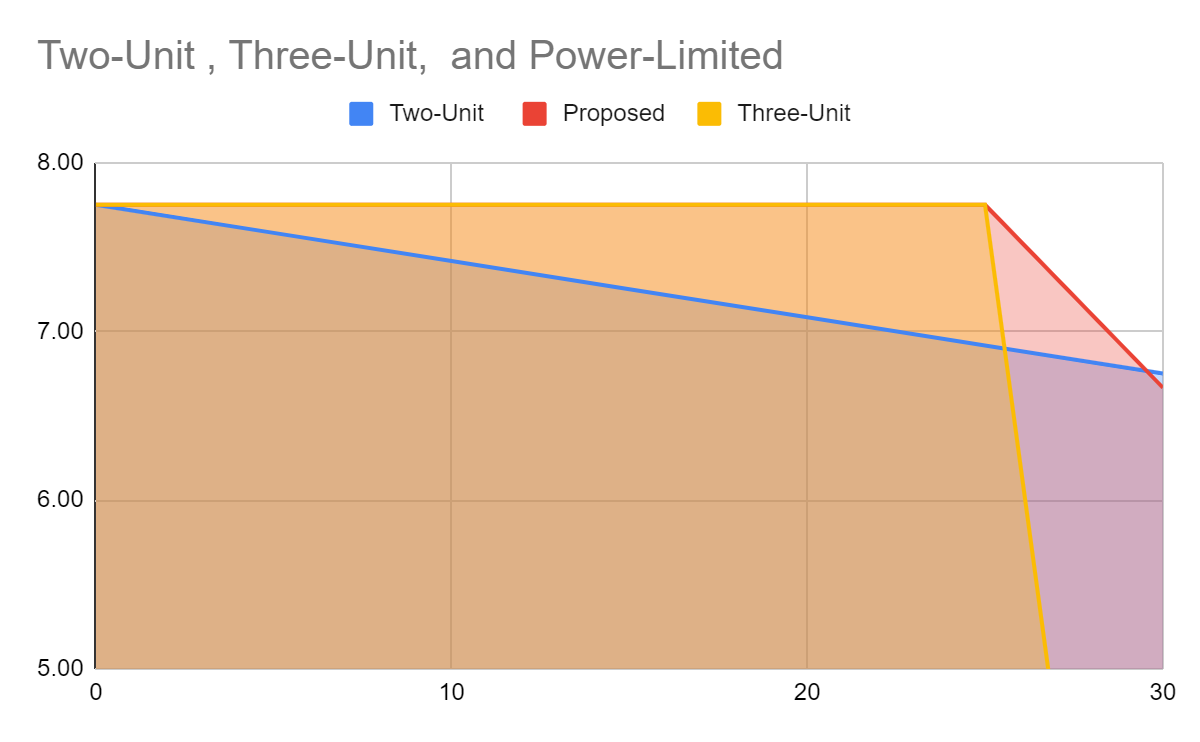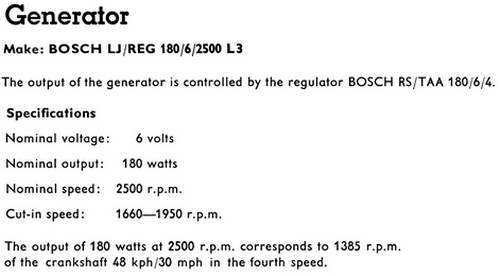Hello everyone,
I've spun this off from the thread "Automotive 6 Volt Generator Transistor Voltage Regulator." I've been inspired by Danwvw and also herbie1200 on TheSamba (see Homemade solid state 6V regulator and Solid state 6 volt regulator ) to try my hand at designing and building a voltage regulator for my '64 Karmann Ghia, possibly usable for other applications. I want to use a microcontroller to make the regulator programmable and allow for some optimization of the regulator's characteristic curve.
This is an open source project.
What follows are the requirements I've come up with. I'd welcome any comments or advice. I mentioned in the other thread that I work with microcontrollers. I probably should also mention that I am the "software guy" in our little operation. When I get into the design, I'm really going to need help on the analog/power stuff.
Problem Statement
Produce a drop-in replacement for the BOSCH 7V 45A generator voltage regulator commonly used on early VW engines. The replacement should optimize charging while keeping the generator and battery within recommended parameters. The regulator should be configurable for either ordinary lead-acid battery or AGM battery (e.g., Optima), and possibly 6, 8, or 12 volt battery. It would be nice to maintain the original external appearance. It should cost less than $100 to build (including the cost of any special tools needed).
External Interfaces
Here is a diagram of the original regulator in my car:
 There are 4 electrical interfaces to the regulator:
There are 4 electrical interfaces to the regulator:

Theory of Operation
 Taking the Two-unit TA regulator curve (above) for example, the regulator is limiting this generator to roughly 30A x 6.75V = ~200 Watts load. But, if you back up to 15A it is capped to 7.25V which is only ~109 watts. Why not stay at 7.75V x 15A = 116 watts? It could stay at 7.75V until 200W/7.75V = ~26A, and then drop off steeply to stay in a 200W envelope. From 26A, it would drop at a slope of
Taking the Two-unit TA regulator curve (above) for example, the regulator is limiting this generator to roughly 30A x 6.75V = ~200 Watts load. But, if you back up to 15A it is capped to 7.25V which is only ~109 watts. Why not stay at 7.75V x 15A = 116 watts? It could stay at 7.75V until 200W/7.75V = ~26A, and then drop off steeply to stay in a 200W envelope. From 26A, it would drop at a slope of
(6.75 - 7.75) / (30 - 26) = -1 V / 4A
This scheme would allow it to keep going up to higher current until the voltage is low enough that current to the battery naturally levels off.
Requirements

There are a few solid state regulators available on the market:
Did I miss anything?
-Carl
I've spun this off from the thread "Automotive 6 Volt Generator Transistor Voltage Regulator." I've been inspired by Danwvw and also herbie1200 on TheSamba (see Homemade solid state 6V regulator and Solid state 6 volt regulator ) to try my hand at designing and building a voltage regulator for my '64 Karmann Ghia, possibly usable for other applications. I want to use a microcontroller to make the regulator programmable and allow for some optimization of the regulator's characteristic curve.
This is an open source project.
What follows are the requirements I've come up with. I'd welcome any comments or advice. I mentioned in the other thread that I work with microcontrollers. I probably should also mention that I am the "software guy" in our little operation. When I get into the design, I'm really going to need help on the analog/power stuff.
Problem Statement
Produce a drop-in replacement for the BOSCH 7V 45A generator voltage regulator commonly used on early VW engines. The replacement should optimize charging while keeping the generator and battery within recommended parameters. The regulator should be configurable for either ordinary lead-acid battery or AGM battery (e.g., Optima), and possibly 6, 8, or 12 volt battery. It would be nice to maintain the original external appearance. It should cost less than $100 to build (including the cost of any special tools needed).
External Interfaces
Here is a diagram of the original regulator in my car:
- B+/Terminal 51: direct connection to car battery
- D-/Ground: generator armature winding negative and chassis ground
- D+/Terminal 61: generator armature winding positive and warning light
- DF: generator field winding
- Cut-out: B+, the connection to the battery, is open circuited
- Cut-in Voltage: When the regulator is in cut-out state and the generator voltage is increasing, this is the voltage at which the regulator makes a connection between B+ of the regulator and D+ of the generator. From there the charging current can flow to the battery or into the electrical system.
- Cut-out Voltage: When the regulator is in cut-in state and generator voltage is decreasing, this is the voltage at which the regulator breaks the connection between B+ of the regulator and D+ of the generator. This prevents the battery from discharging through the generator. (This was a tunable parameter for the original regulator, but will probably not be used in my design.)
- Regulating Voltage: The voltage at which the regulator prevents any further rise in voltage
- Regulating Current: The current at which the regulator prevents any further increase in current
- Idiot Light: generator and cooling warning lamp on the car's dashboard (in the speedometer):
Theory of Operation
- When conditions are right, the regulator connects the D+/Terminal 61 (generator armature winding) to B+/Terminal 51 (direct connection to car battery) to allow the generator to charge the battery and supply current to the car.
- The regulator adjusts the generator field current (through D+/Terminal 61) to control the generator’s output voltage. It must limit the output voltage according to the specifications of the battery and the car’s electrical system.
- The regulator must limit the power produced to avoid overloading the generator. It can do this by reducing the output voltage when current is high, or by maintaining a constant voltage up to a preset current limit at which it cuts out.
- The original BOSCH two-unit regulator, consisting of a cut-out relay and a compensated voltage regulator relay, limits voltage such that the higher the current, the lower the voltage supplied by the generator. This protects the generator against overloading. This characteristic of the regulator can be seen in the following graph:
- BOSCH (and others) also made three-unit regulators, consisting of a cut-out relay, a voltage regulator relay, and a current relay. These have a step-function characteristic; constant voltage up to a cutoff at a fixed current.
- I’m proposing an optimized regulator that maintains a constant voltage as current rises up to a fixed power limit. Beyond that point, voltage begins to fall as current continues to rise, in order to maintain a constant power.
(6.75 - 7.75) / (30 - 26) = -1 V / 4A
This scheme would allow it to keep going up to higher current until the voltage is low enough that current to the battery naturally levels off.
Requirements
- Voltage & Current regulation: this needs to be configurable. For example, from 1965:
- Over the years VWs had 6/7V generators that were 90, 160, 180 watts, at least. And then a variety of 12/14V generators. Regulators were originally matched to generators.
- It would be nice to have a universal design that could be configured for 6V, 8V, or 12V battery (standard lead acid, or Absorbent Glass Mat [AGM]) and a specified generator wattage.
- I think specifying battery charging voltage range and generator wattage rating should be sufficient to characterize the regulator.
- Limit voltage and current in such a way as to optimize ampere-hour input to the battery in a given time.
- Cut-in: Optima specifies "Recommended charging information: Alternator: 6.65 to 7.5 volts, no amperage limit." for the REDTOP battery. So, for this example, I think the cut-in voltage should be 6.65.
- Regulating Voltage: Once cut-in, limit voltage to the top of the recommended charging voltage range; e.g., 7.5 volts for the Optima. As current increases and reaches the point where the product of the voltage and current is equal to the generator power limit, begin reducing voltage stay within the power limit.
- Cut-out: When cut-in, as generator speed decreases and output voltage falls, the regulator should monitor the current to the B+ terminal and cut-out when flow is no longer positive. There probably also needs to be some hard voltage limit, in case there is a short or something. There probably should also be some hard limit on current.
- User interface:
- Dashboard idiot light (incandescent, original equipment):
- Steady on: no generator output
- Slow flash: low battery voltage
- Fast flash: over voltage or over current (or over heat?)
- Configuration interface: This needs some thought. The prototype, at least, will have a USB port to connect a terminal. Other ideas: a pushbutton and an LED or LCD on the regulator (under the cover?)? DIP switches?
- Dashboard idiot light (incandescent, original equipment):
- Normal
- Turning the key on puts battery voltage on the other end of the (incandescent) idiot light connected to D+/Terminal 61. The regulator senses this non-zero voltage and powers up from B+/Terminal 51.
- When the ignition key is on, but the generator is not turning, idiot light glows.
- Once generator is producing a detectable voltage, idiot light is turned off.
- The regulator initially grounds DF (generator field winding) to demand maximum voltage from the generator.
- Dead battery
- Is it reasonable to require at least a little bit of battery power; just enough to power up the MCU through a buck/boost circuit?
- Trying to run off the generator alone, no battery, would be difficult.
- Maybe add a little rechargeable lithium backup battery?
- When the generator starts turning fast enough to produce at least the Cut-in Voltage, the regulator cuts in and connects D+/Terminal 61 to B+/Terminal 51.
- The regulator remains cut in as long as there is a positive current flow from the generator to the battery, unless the voltage drops to something abnormally low.
- Once cut in, the regulator rapidly switches DF on and off to regulate the generated voltage and current, as described above.
- When the key is switched off, D+/Terminal 61 is no longer powered on the other side of the bulb. The regulator senses this and powers down.
- When the regulator is powered down, it must be cut out.
- Broken fan belt: the generator stops turning, the current reverses and the regulator cuts out. The regulator senses 0 voltage on D+/Terminal 61 and lights the idiot light steadily.
- Low battery voltage: the regulator senses abnormally low voltage on B+/Terminal 51 and slow flashes the idiot light.
- High battery voltage: the regulator senses abnormally high voltage on B+/Terminal 51 and fast flashes the idiot light.
- Short circuit: the regulator senses high current and low voltage on B+/Terminal 51 and fast flashes the idiot light, and maybe cuts out?
- Open circuit? Sense no/low current on B+/Terminal 51?
- High temperature?
There are a few solid state regulators available on the market:
- Wolfsburg West: $185.00
- **broken link removed**: USD $80.99
- Custom & Commercial: £74.99 Each Inc VAT
- Paruzzi: € 61,98 excluding VAT
- Clover Systems (No longer available?) See Solid state 6 volt regulator.
Did I miss anything?
-Carl
Last edited:

